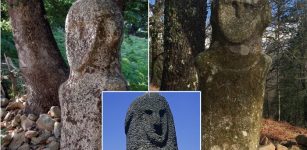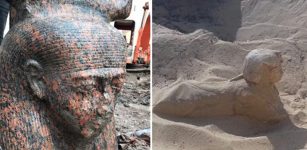Pakhet ‘Night Huntress’: Egyptian War-Like Lioness Goddess Associated With Artemis
A. Sutherland - AncientPages.com - In the Egyptian pantheon, Pakhet is a fierce lioness (or panther) goddess of war.
Her name means (‘she who scratches ‘ or ‘tearer’) and one of her titles is ‘Goddess at the Entrance of the Wadi’ probably referring to the lion’s habit to appear in places with water located at the edge of the desert.

Seti I and Pakhet in the sacred shrine Speos Artemidos. Image source
More exactly, as a lioness goddess, Pakhet ruled the Eastern part of Sahara Desert, located east of the Nile river, between the river and the Red Sea. Referred to as “She Who Opens the Ways of the Stormy Rains”), Pakhet was linked to rapid flooding taking place in the region and desert storms, in the same way as another Egyptian lioness and aggressive hunter of the desert, Sekhmet.
Amulets Of Pakhet Were Believed To Protect
She was not frequently portrayed in ancient Egyptian art, but her most usual depictions show her in the form of a lioness-headed woman or as a feline, killing snakes with her sharp claws. Pakhet’s claw amulets were worn by royal women to provide protection and fertility and happy motherhood.
Other amulets usually depicted the lion goddess standing over her fallen captives and prey – a representation of the subdued chaos she signified.
While merged into a three-headed deity with Mut (Egyptian mother goddess) and Nekhbet (associated with Ra and Osiris), Pakhet kept the deceased from coming to harm.
Sacred Shrine Of Pakhet In Speos Artemidos
This goddess was worshiped in Speos Artemidos, an ancient Egyptian rock shrine, situated in a lonely desert valley south of the tombs at Beni Hasan, on the east bank of the Nile. It is believed the shrine was carved out of the limestone in the 18th Dynasty during the reign of Hatshepsut and Tuthmosis the 3rd.
In Hellenistic times, Pakhet was identified with Artemis, Greek goddess of the hunt, forests, archery, wild animals. This explains Greek name of the rockshrine, ‘Speos Artemidos’ - Artemis Sanctuary or Cave of Artemis.
See also:
Sokar – Patron Deity Of Ancient Necropolis Of Memphis In Lower Egypt
Geb – Egyptian God Of Earth And Member Of The Ennead – His Laughter Created Earthquakes
Khepri – Egyptian Progenitor God, Spirit Of Life, Resurrection And The Rising Sun
At Speos Artemidos, there is an inscription by the Pharaoh Hatshepsut that credits Pakhet, "mistress of the desert plateau... who roams the wadis in the midst of the East with having "opened the roads for the water-torrent without drenching me, in order to catch the water…'

The rock cut temple of Pakhet by Hatshepsut in Speos Artemidos. Image source
One more ancient temple dedicated Pakhet was at this particular location; however, the structure has not survived. The pharaoh Hatshepsut was known to have restored temples in the region, which was badly damaged by the Hyksos invasion in 1650 BC.
In 'Coffin Texts', spell 470, Pakhet is introduced as a night huntress - "Pakhet the Great, whose eyes are keen and whose claws are sharp, the lioness who sees and catches by night."
Other titles and epithets of Pakhet include 'Horus Pakhet', due to many mummified hawks unearthed at the site, as well as 'Pakhet-Weret-Hekau' (“She who has great magic), implying her association with Hathor or Isis.
Written by – A. Sutherland - AncientPages.com Senior Staff Writer
Copyright © AncientPages.com All rights reserved. This material may not be published, broadcast, rewritten or redistributed in whole or part without the express written permission of AncientPages.com
Expand for referencesMore From Ancient Pages
-
 Archaeological Discoveries At Fort San Juan Reveal Hidden History Of Conquistadors In American South
Archaeology | Mar 12, 2018
Archaeological Discoveries At Fort San Juan Reveal Hidden History Of Conquistadors In American South
Archaeology | Mar 12, 2018 -
 Harappan Civilization Built Massive Protection Walls Against Tsunami 5,000 Years Ago
Archaeology | Jan 10, 2017
Harappan Civilization Built Massive Protection Walls Against Tsunami 5,000 Years Ago
Archaeology | Jan 10, 2017 -
 The Green Knight – New Movie Based On Arthurian Legend
Myths & Legends | Aug 7, 2021
The Green Knight – New Movie Based On Arthurian Legend
Myths & Legends | Aug 7, 2021 -
 Giant Meteorite Impacts Created The Continents – Evidence Found
Human Beginnings | Aug 12, 2022
Giant Meteorite Impacts Created The Continents – Evidence Found
Human Beginnings | Aug 12, 2022 -
 Traces Of The Watchers In Ancient China Shed New Light On This Mysterious Lost Race
Civilizations | Aug 11, 2018
Traces Of The Watchers In Ancient China Shed New Light On This Mysterious Lost Race
Civilizations | Aug 11, 2018 -
 Robert Fortune’s Dangerous Mission To Obtain Tea From The Chinese
Featured Stories | Feb 24, 2020
Robert Fortune’s Dangerous Mission To Obtain Tea From The Chinese
Featured Stories | Feb 24, 2020 -
 Corsica: ‘The Island Of Statue-Menhirs’ – Where Humans Lived At Least 7,000 BC
Featured Stories | Feb 28, 2024
Corsica: ‘The Island Of Statue-Menhirs’ – Where Humans Lived At Least 7,000 BC
Featured Stories | Feb 28, 2024 -
 Aboriginals Inhabited South Australia 29,000 Years Ago – New Study
Archaeology | Jul 15, 2020
Aboriginals Inhabited South Australia 29,000 Years Ago – New Study
Archaeology | Jul 15, 2020 -
 900-Year-Old Coins And Jewelry Unearthed In Polish Village – Could They Belong To A Ruthenian Princess?
Artifacts | Jan 12, 2021
900-Year-Old Coins And Jewelry Unearthed In Polish Village – Could They Belong To A Ruthenian Princess?
Artifacts | Jan 12, 2021 -
 Mary Boleyn – King Henry VIII’s Other Woman And Sister Of Anne Boleyn
Featured Stories | Jul 24, 2018
Mary Boleyn – King Henry VIII’s Other Woman And Sister Of Anne Boleyn
Featured Stories | Jul 24, 2018 -
 Ancient DNA Has Traced Large-Scale Migrations Into Bronze Age Britain And The Emergence of The Celtic Language
Archaeology | Dec 30, 2021
Ancient DNA Has Traced Large-Scale Migrations Into Bronze Age Britain And The Emergence of The Celtic Language
Archaeology | Dec 30, 2021 -
 Rare Statue With A Ka Symbol And A Dwarf Sphinx Discovered In Egypt
Archaeology | Dec 18, 2019
Rare Statue With A Ka Symbol And A Dwarf Sphinx Discovered In Egypt
Archaeology | Dec 18, 2019 -
 Mictlan – Underworld Realm Of The Dead In Ancient Aztec Beliefs
Aztec Mythology | Jul 2, 2018
Mictlan – Underworld Realm Of The Dead In Ancient Aztec Beliefs
Aztec Mythology | Jul 2, 2018 -
 Is Mysterious Herlaugshaugen The Ship Burial Of Viking King Herlaug?
Archaeology | Jul 11, 2023
Is Mysterious Herlaugshaugen The Ship Burial Of Viking King Herlaug?
Archaeology | Jul 11, 2023 -
 Whose Ancient Burials Are Hidden Inside The Vatican City’s Walls?
Archaeology | Mar 11, 2021
Whose Ancient Burials Are Hidden Inside The Vatican City’s Walls?
Archaeology | Mar 11, 2021 -
 Magnificent Pagodas In Indein Village And Undiscovered Secrets In The Myanmar Jungle
Featured Stories | Oct 9, 2020
Magnificent Pagodas In Indein Village And Undiscovered Secrets In The Myanmar Jungle
Featured Stories | Oct 9, 2020 -
 Garden Of Eden And Its Four Rivers – Possible Locations Of Biblical Paradise Suggested By Archaeologists, Historians And Biblical Scholars
Biblical Mysteries | May 29, 2017
Garden Of Eden And Its Four Rivers – Possible Locations Of Biblical Paradise Suggested By Archaeologists, Historians And Biblical Scholars
Biblical Mysteries | May 29, 2017 -
 Neanderthals Buried Their Dead And Developed Spirituals Beliefs – Did Neanderthals Practice Religion?
Featured Stories | Dec 28, 2016
Neanderthals Buried Their Dead And Developed Spirituals Beliefs – Did Neanderthals Practice Religion?
Featured Stories | Dec 28, 2016 -
 Mysterious Clay Tablet Reveals Babylonians Used Trigonometry 1,000 Years Before Pythagoras
Archaeology | Aug 24, 2017
Mysterious Clay Tablet Reveals Babylonians Used Trigonometry 1,000 Years Before Pythagoras
Archaeology | Aug 24, 2017 -
 Wari Culture: Ancient Astronomical Observatory Excavated In Cusco, Peru
Archaeology | Dec 20, 2017
Wari Culture: Ancient Astronomical Observatory Excavated In Cusco, Peru
Archaeology | Dec 20, 2017
